WeLoveDC authors Cathy (cooking queen) and Katie (restaurant aficionado) have paired up to bring you a double-hitting feature about great seasonal dishes that chefs at local area restaurants are whipping up this fall. Katie gets insider info about the chef and the restaurant, and Cathy recreates the chef’s recipe at home. Cheers to that.
After our previous adventure with Glenn Babcock of Nage Bistro, Cathy and I were invited to cook a seasonal fall dish with Westend Bistro by Eric Ripert‘s Chef de Cuisine, Joe Palma.
It was early Saturday morning on a perfect fall day, the type that is sunny and warm but with crisp, fresh air. Cathy and I were trailing chef Joe Palma through the Old Town farmers market in Alexandria as he pondered what seasonal dish to show us how to make.
“I sort of just wander around and see what looks good,” he said. “Kind of like Top Chef?” I tossed out. “Yeah,” he replied. “I can create bistro food on the fly, but I don’t think I’d enjoy being thrown a random ingredient.” And yet, that’s sort of what happened that Saturday morning at the market. Palma paused at the pears, then brussel sprouts caught his eye. “You guys like brussel sprouts?” he asked. “Yeah”, Cathy and I chimed. “How about green tomatoes?” “Of COURSE! I’m a southern girl!” I laughed. If Palma thinks it would be good, I’m totally happy to eat it. He’s one of the few chefs in the city that I have complete blind faith in.
Westend Bistro is currently my favorite restaurant in DC, and that’s quite a proclamation. I rarely choose favorites (don’t ever ask me my favorite book!) but I think there’s something uniquely lovely about Westend. I spend a lot of my time in restaurants these days, and Westend rises to the top of my list every time. Maybe it’s the relaxed, yet sophisticated atmosphere. Maybe it’s the buzz of the place, and the fact the wait staff are trained in the ways of the Ritz-Carlton. But mostly, I believe it’s that Palma puts the focus solely on the ingredients and purchases only the best possible.
“When I first came on, I cut costs down to about 28%, and it should be at about 32%,” Palma said. “I used that margin of cost savings to find the best possible ingredients, meats, produce.” It shows. Westend’s food is simple food. Sous Chef Adam Barnett told me one night that he likes working for Palma because he doesn’t get fussy with his food. Barnett said Palma doesn’t pile ingredients on a plate, that chef thinks about his ingredients before assembling them. So how would that translate for Cathy and I learning how to cook one of Palma’s dishes?
“So, how about a green tomato salad with short ribs and brussel sprouts?” Palma tossed out as we looked out on the market. And it was settled. It sounded complicated to me, but again, with my blind faith. I was up for anything. We walked around the Old Town Square picking up our ingredients, then caught a ride in his black super-fancy hotel car back to the Ritz-Carlton, home of Westend Bistro.
“You have to think of a dish like a symphony,” he explained as we rode back. “Each part of it needs to come together at the exact right time, and compliment the other part.” The symphony metaphor seems to be how Palma thinks of his restaurant as a whole. I’ve had the pleasure of dining at Westend Bistro seated at “The Pass” twice now. The pass is the long counter where the dishes go out from the kitchen and are picked up by the wait staff. Two chairs are located side-by-side at the far end of the long counter facing into the kitchen. Those two seats rank up there as one my favorite places in DC. I love watching the movement in the kitchen, and Palma and Barnett are great hosts. (The pass is available to the general public to reserve at no extra cost, I’d highly recommend it.) But not only is it fun to joke around with the guys, I also find it interesting to see how Palma conducts his kitchen.
Training is key, Palma explains. “You can’t just hand someone a trumpet and expect them to be a star musician.” It’s all about the basics and the details in his kitchen. From pitch-perfect sauces,to layering a dish with flavors, he puts incredible thought into each plate of food he makes and expects his staff to do the same. He talks fondly about each of his line cooks, their strengths and weaknesses, what will make them good chefs in the future. He also arranges his kitchen to be a team, explaining how certain stations work, and how he expects his sous chefs to jump on the line at any point in a busy night. “We rise and fall together,” he states emphatically. That seems to be the bottom line.
Palma has trained under some greats, working at Citronelle, Le Paradou and up in New York directly under Ripert at the famed Le Bernardin. Palma never went to culinary school; instead, he attended the College of Charleston for Economics, quite a far cry from where he is today. He believes his experience working his way up in the kitchen is invaluable and hesitates to take culinary students on as part of his staff. He thinks line cooks need to listen and to have hands on experience in different kitchens to learn, something evidenced by his own background. In 1998, when Palma was on the line at Citronelle, he cooked side-by-side with Chef Koslow (now Executive Chef at Tallula/Eat Bar), Chef Tanaka (of Cork) and Chef Maupillier (of Michel Richard’s Central). Talk about DC’s dream team.
Cathy and I watched as Palma whipped up a green tomato salad with blue cheese dressing, decorated the plate with a few key greens and walnuts. Watching him compose a dish, we see first hand that Chef really does let the ingredients speak for themselves. Each component is balanced with another, the brussel sprouts were sauteed in a straightforward sage butter sauce and came out delicate and delicious, the little cabbages complimented by the flavors, but not overwhelmed.
The meal wound up being much easier than it sounded, even in a fancy industrial kitchen. The tomatoes needed chopped, the pears cut into matchsticks, the dressing mixed and then everything arranged on the plate. It was as uncluttered as that. The short ribs had a unfussy sauce that he dictated to Cathy. Uncomplicated, but also brilliant. But how is such basic food so outstanding? Palma swears it’s that he thinks about it more than other chefs. Everyone works from the same ingredients, it’s the thought process that determines cooks from chefs. Again, with the symphony metaphor, Palma relates how he thinks through dishes: “I think of it like a piece of music in a performance, each instrument adding its own sound.” I can tell this just by eating his green tomato salad – the acidic tomato combined with the sweet pear, accented with savory blue cheese.
Everything for a reason.
I’m always impressed with Westend Bistro: from the cocktails to the service, I adore it in there. Warm, friendly, and most importantly, just plain and simple good food.
Could Cathy create a repeat symphony on her plate after learning from Chef? Come back at 3 p.m. to find out.
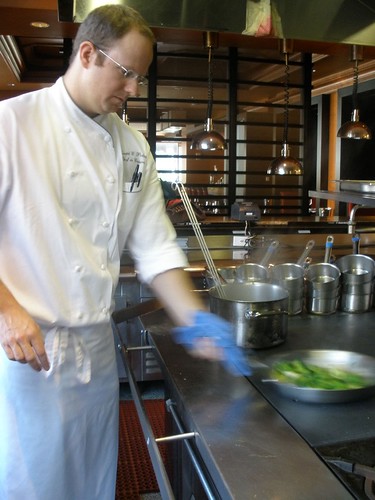
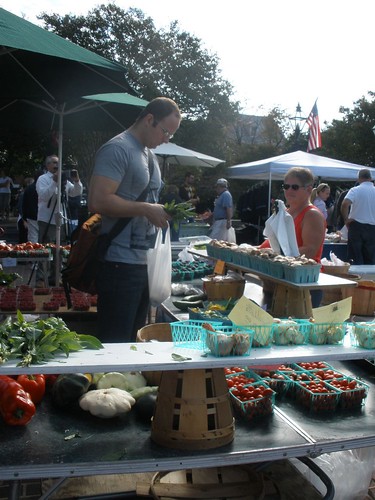
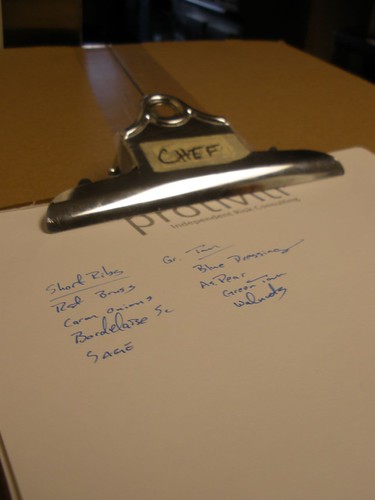
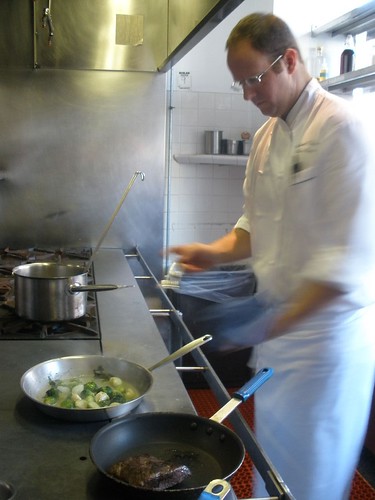


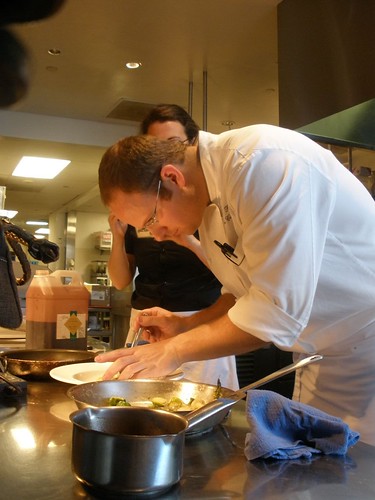
Pingback: Capital Chefs: Cooking with Chef Palma of Westend Bistro, Part II » We Love DC
I love Westend Bistro! They have the best food! Thanks for the great pictures!
“Chef Maupillier (of Cork). Talk about DC’s dream team.”
Hi Katie! Chef Maupillier is the chef at Central Michel Richard, not Cork. :) great article!
Good catch, Tina, it got mixed up in editing. Thanks, fixed! :)